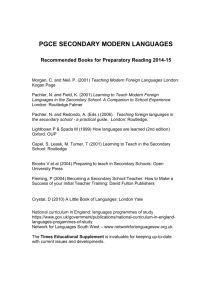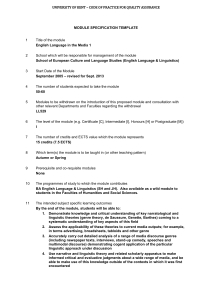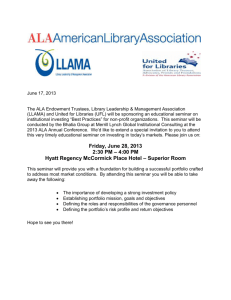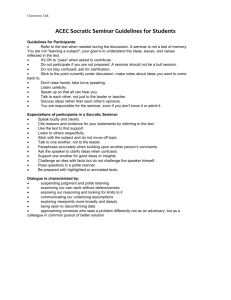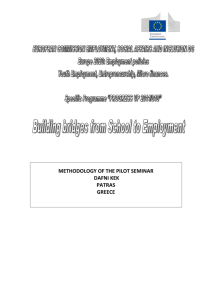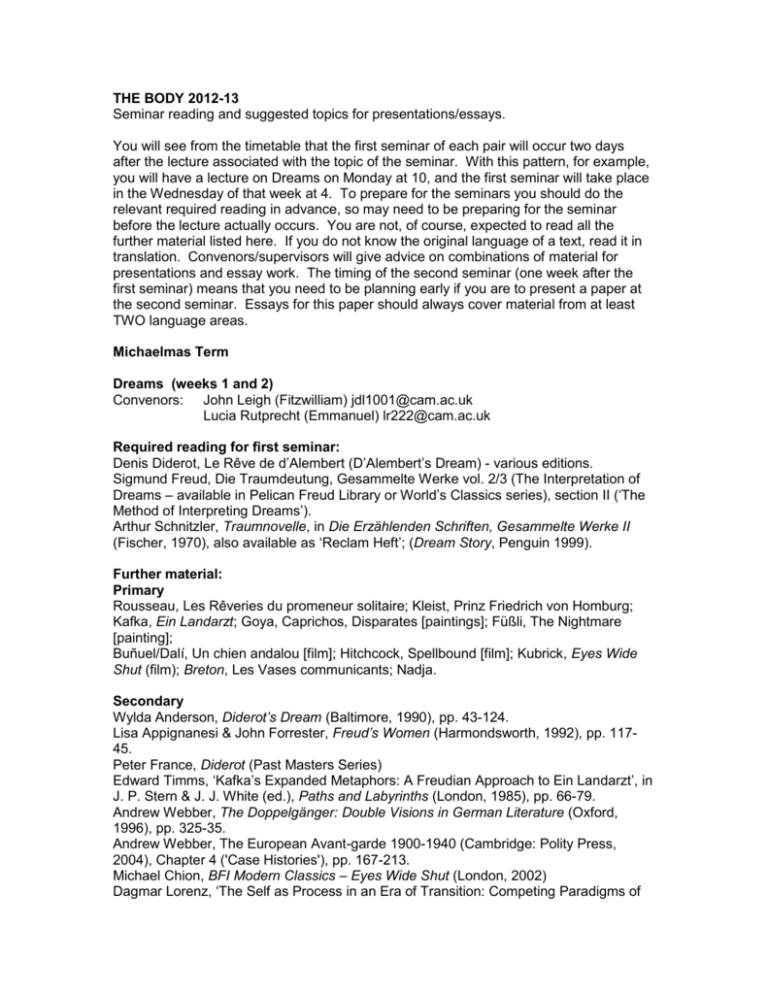
THE BODY 2012-13
Seminar reading and suggested topics for presentations/essays.
You will see from the timetable that the first seminar of each pair will occur two days
after the lecture associated with the topic of the seminar. With this pattern, for example,
you will have a lecture on Dreams on Monday at 10, and the first seminar will take place
in the Wednesday of that week at 4. To prepare for the seminars you should do the
relevant required reading in advance, so may need to be preparing for the seminar
before the lecture actually occurs. You are not, of course, expected to read all the
further material listed here. If you do not know the original language of a text, read it in
translation. Convenors/supervisors will give advice on combinations of material for
presentations and essay work. The timing of the second seminar (one week after the
first seminar) means that you need to be planning early if you are to present a paper at
the second seminar. Essays for this paper should always cover material from at least
TWO language areas.
Michaelmas Term
Dreams (weeks 1 and 2)
Convenors: John Leigh (Fitzwilliam) jdl1001@cam.ac.uk
Lucia Rutprecht (Emmanuel) lr222@cam.ac.uk
Required reading for first seminar:
Denis Diderot, Le Rêve de d’Alembert (D’Alembert’s Dream) - various editions.
Sigmund Freud, Die Traumdeutung, Gesammelte Werke vol. 2/3 (The Interpretation of
Dreams – available in Pelican Freud Library or World’s Classics series), section II (‘The
Method of Interpreting Dreams’).
Arthur Schnitzler, Traumnovelle, in Die Erzählenden Schriften, Gesammelte Werke II
(Fischer, 1970), also available as ‘Reclam Heft’; (Dream Story, Penguin 1999).
Further material:
Primary
Rousseau, Les Rêveries du promeneur solitaire; Kleist, Prinz Friedrich von Homburg;
Kafka, Ein Landarzt; Goya, Caprichos, Disparates [paintings]; Füßli, The Nightmare
[painting];
Buñuel/Dalí, Un chien andalou [film]; Hitchcock, Spellbound [film]; Kubrick, Eyes Wide
Shut (film); Breton, Les Vases communicants; Nadja.
Secondary
Wylda Anderson, Diderot’s Dream (Baltimore, 1990), pp. 43-124.
Lisa Appignanesi & John Forrester, Freud’s Women (Harmondsworth, 1992), pp. 11745.
Peter France, Diderot (Past Masters Series)
Edward Timms, ‘Kafka’s Expanded Metaphors: A Freudian Approach to Ein Landarzt’, in
J. P. Stern & J. J. White (ed.), Paths and Labyrinths (London, 1985), pp. 66-79.
Andrew Webber, The Doppelgänger: Double Visions in German Literature (Oxford,
1996), pp. 325-35.
Andrew Webber, The European Avant-garde 1900-1940 (Cambridge: Polity Press,
2004), Chapter 4 ('Case Histories'), pp. 167-213.
Michael Chion, BFI Modern Classics – Eyes Wide Shut (London, 2002)
Dagmar Lorenz, ‘The Self as Process in an Era of Transition: Competing Paradigms of
Personality and Character in Schnitzler’s Works, in Dagmar Lorenz (ed.), A Companion
to the Works of Arthur Schnitzler (New York 2003).
Egon Schwarz, ‘A Puzzle and an Enigma: Stanley Kubrick’s Eyes Wide Shut and Arthur
Schnitzler’s Traumnovelle’, Modern Austrian Literature Vol. 34 No. 1/2, 2001, 103-112.
Topics for essays/presentations:
1. Dreaming is the elusive, liminal zone between the expression of the body and the
constraints of the mind.
2. Dreams, as explored by literary texts or other cultural forms, venture not so much into
the unknown as the repressed.
3. Behind every dream there is a sexual wish.
4. Dreams are profoundly bound up with the body’s subjection to time.
5. Dreaming is a process of healing: a reconstruction of the sick or wounded psyche.
6. Our understanding of dreams is always defined by their embodiment in the medium of
language.
7. The dream body is always monstrous, displaying disfigurement and hybridity.
8. The disembodied physicality of film makes it the ideal medium for representing
dreams.
Beauty and the Beast (Weeks 3 and 4)
Convenors: Andy Martin am260@cam.ac.uk
Ian James (Downing) irj20@cam.a.c.uk
The preliminary reading for this seminar is the same as that given for the lecture You
should also read the following essays in preparation for the seminar:
Georges Bataille, ‘Figure Humaine’, ‘Informe’, ‘Le Bas matérialisme et la gnose’, ‘Les
Écarts de la nature’ in Œuvres complètes, vol. 1 (Paris : Gallimard : 1970), pp. 181-85,
217, 220-26, 228-30
Georges Bataille, ‘Formless’, ‘Base Materialism and Gnosis’, ‘The Deviations of Nature’
in Visions of Excess, Allen Stoekl (ed.) (Minneapolis: University of Minnesota Press,
1985), pp. 31-58
Queer Fellows (Weeks 5 and 6)
Convenors: Stuart Davis (Clare and Girton) sd367@cam.ac.uk
Annie Ring aghring@gmail.com
Required Reading for first seminar
Literary
Franz Kafka, Der Proceß, Penguin Modern Classics
1996).
Theoretical
Judith Butler, Gender Trouble: Feminism and the Subversion of Identity (New York:
Routledge, 1990), pp. 128-49
Eve Kosofsky Sedgwick, Epistemology of the Closet (New York & London: Harvester
Wheatsheaf, 1991), pp. 1-63.
Further Material:
Primary
A Literary texts—options for essays on roughly Modernist material *Wilde, The Picture
of Dorian Gray; Forster, Maurice; Genet, Querelle de Brest/ Notre-Dame-des-Fleurs;
Gide, L’Immoraliste; Gómez de la Serna, La quinta de Palmyra; Kafka, Der Proceß;
Kuzmin, Kryl’ia; Lorca, El público; Musil, Die Verwirrungen des Zöglings Törleß; Pasolini,
Amado mio/Atti impuri; Radclyffe Hall, The Well of Loneliness; Tsvetaeva, Mon frère
feminin: Lettre à l’amazone; Hernández Catá El ángel de Sodoma; D’Halmar La pasión y
muerte del cura Deusto (see Dr Davis for copies of these two Spanish texts).
B Filmography—films with literary intertexts
(Proust) Chantal Akerman, La Captive, 2000 ; (Mann) Luchino Visconti, Morte a
Venezia, 1971 ; (Herman Melville) Claire Denis, Beau Travail; (Tennessee Williams)
Pedro Almodóvar, Todo sobre mi madre, 1999; (Genet) Rainer Werner Fassbinder,
Querelle, 1982.
Secondary (General; Literary; Queer and Film Theory)
Abelove, Henry et al. (ed.), The Lesbian and Gay Studies Reader (New York: Routledge,
1993)
Bersani, Leo, Homos (Cambridge Mass.: Harvard UP, 1995)
Bowie, Malcolm, Freud, Proust and Lacan: Theory as Fiction (Cambridge: CUP, 1987)
Butler, Judith, Bodies That Matter: On the Discursive Limits of “Sex” (New York:
Routledge, 1993)
———, Gender Trouble: Feminism and the Subversion of Identity (NewYork: Routledge,
1990)
Cohen, Ed, ‘Writing gone Wilde: Homoerotic Desire in the Closet of Representation’,
PMLA 102 (1987), 802-13.
Costlo, J. et al (ed.), Sexuality and the Body in Russian Culture (Stanford CA: Stanford
UP, 1993).
Deleuze, Gilles, Proust et les signes (Paris: Presses Universitaires de France, 1964)
Dollimore, Jonathan, Sexual Dissidence: Augustine to Wilde, Freud to Foucault (Oxford:
OUP, 1991)
Dyer, R., Now You See It: Studies on Lesbian and Gay Film (London: Routledge, 1990)
Edelman, Lee, Homographesis: Essays in Gay Literary and Cultural Theory (New York &
London: Routledge, 1994)
Finn, Michael, Proust, the Body and Literary Form (Cambridge: CUP, 1999)
Freud, Sigmund, Three Essays on the Theory of Sexuality (Penguin Freud Library VII)
Fuss, Diane (ed.), inside/out: Lesbian Theories, Gay Theories (New York & London:
Routledge, 1991)
Gordon, Robert, Pasolini: Forms of Subjectivity (Oxford: Clarendon, 1996)
Grosz, Volatile Bodies: Towards a Corporeal Feminism (Bloomington and Indianapolis:
Indiana University Press, 1994)
———, Space, Time and Perversion: Essays on the Politics of Bodies (New York:
Routledge, 1995)
Hayes, Tom, & Lee Quinby, ‘The Aporia of Bourgeois Art: Desire in Thomas Mann’s
Death in Venice’, Criticism XXXI.2 (Spring, 1989), 159-77.
Heilbut, Anthony, Thomas Mann: Eros and Literature (London: Macmillan, 1996)
Houellebecq, Michel, Les Particules Élémentaires (Paris: Flammarion, 1998)
Hughes, Alex, Heterographies: Sexual Difference in French Autobiography (Oxford:
Berg, 1999)
Irigaray, Luce, Éthique de la différence sexuelle (Paris: Minuit, 1984)
Lamos, Colleen, Deviant Modernism: Sexual and Textual Errancy in T. S. Eliot,
James Joyce, and Marcel Proust (Cambridge: CUP, 1998)
MacCannell, Juliet Flower, ed., Thinking Bodies (Stanford: Stanford University Press,
1994)
Robinson, Christopher, Scandal in the Ink: Male and Female Homosexuality in
Twentieth-Century French Literature (London: Cassell, 1995)
Sedgwick, Eve Kosofsky, Between Men: English Literature and Homosocial Desire (New
York: Columbia UP, 1985)
The Sexual Subject: A ‘Screen’ Reader in Sexuality (London: Routledge, 1992)
Silverman, Kaja, Male Subjectivity at the Margins (New York & London: Routledge,
1992)
———, The Threshold of the Visible World (New York; London: Routledge, 1996)
Smith, Paul Julian, The Body Hispanic: Gender and Sexuality in Spanish and Spanish
American Literature (Oxford: Clarendon, 1989)
Stevens, Hugh, ed., Cambridge Companion to Gay and Lesbian Writing (2010)
Studlar, G., In the Realm of Pleasure (Bloomington and Indianapolis: University of
Indiana Press, 1988)
Wassenaar, Ingrid, Proustian Passions: The Uses of Self-justification for ‘A la recherche
du temps perdu’ (Oxford: OUP, 2000), Chapters 2 & 4.
Webber, Andrew, Sexuality and the Sense of Self in the Works of Georg Trakl and
Robert Musil (London: MHRA/Bithell, 1990), Chapter 6.
———, ‘Mann’s Man’s World: Gender and Sexuality’, in Cambridge Companion to
Thomas Mann, ed. R. Robertson (Cambridge: CUP, 2001)
Wilson, Emma, Sexuality and the Reading Encounter: Identity and Desire in Proust,
Duras, Tournier, and Cixous (Oxford: Clarendon, 1996)
Topics for essays/presentations
1. The representation of homosexuality exposes the limitations of modernism’s ability to
emancipate unspeakable desires.
2. Representations of the homosexual body show that ‘sex’, ‘sexuality’, and ‘gender’ may
be confused but can never be properly synonymous.
3. Human sexuality cannot be treated as a constant essence; it is both indeterminate
and intermittent.
4. The writing of homosexuality shows the body to be “a volume in perpetual
disintegration” (Butler), a text which is never fully legible.
5. Heterosexuality may be compulsory in twentieth-century culture, but its regime can
only work by producing its own fantasies of homosexual inclinations.
6. The homosexual body provokes forms of control and of crisis in both time and space.
7. ‘The filmed body generates an understanding of indifference to sexual difference
which is as troubling as it is liberating.’
8. ‘Representations of the body which cross the divide between the textual and the
visual can work to privilege a merging, rather than a plurality, of sexual identities.’
Discuss specifically in relation to filmic adaptations of literary texts.
Costume (Weeks 7 and 8)
Convenors: Nick White njw16@cam.ac.uk
Stuart Davis (Clare and Girton) sd367@cam.ac.uk
Required reading for first seminar:
Chapters 1 (Nana on stage) & 7 (the ‘mouche d’or’ in front of the mirror) of Emile Zola,
Nana [1880], available in numerous modern French editions (e.g. in volume 2 of the
Gallimard-Pléiade Rougon-Macquart or singly in paperback by Folio or GarnierFlammarion) and in English (by Oxford University Press or Penguin).
Rimbaud’s poem, ‘Vénus anadyomène’ (in most French and English editions, including
Poésies. Une saison en enfer. Illuminations (Paris, Gallimard, 1984), pp.41-42, or in
French at http://www.sunderland.ac.uk/~os0tmc/rimbaud/0.htm, and in English at
http://homepage.ntlworld.com/d.f.semple/index/rimb3.html
Further material:
Primary
Zola, Au Bonheur de dames; Woolf, Orlando; Sacher-Masoch, Venus im Pelz;
Pirandello, Enrico IV; Lorca, El Público; Galdos, La de Bringas; Kunzru, The
Impressionist; Dreiser, Sister Carrie.
J.-K. Huysmans, A Rebours [1884] (Paris: Folio, 1977), trans. by Margaret Mauldon as
Against Nature (Oxford: Oxford University Press, 1998), esp. chapter 5; and his art
criticism in L’art moderne [1883] (Farnborough: Gregg, 1969), reprinted in his Oeuvres
complètes, vol. 6 (Paris: Crès, 1928-34; Genève: Slatkine, 1972); and Certains [1889]
(Farnborough: Gregg, 1970); reprinted in his Oeuvres complètes, vol. 10.
Secondary
Roland Barthes, Le plaisir du texte (Paris: Seuil, 1973) ; The Pleasure of the Text, trans.
Richard Miller (New York : Hill and Wang, 1975)
Peter Brooks, Body Work: Objects of Desire in Modern Narrative (Cambridge MA:
Harvard University Press, 1993), esp. chapter 5, ‘Nana at Last Unveil’d? Problems of the
Modern Nude’, & pp. 278-83
Judith Butler, Gender Trouble: Feminism and the Subversion of Identity (Routledge,
1990)
Bernice Chitnis, Reflecting on Nana (Routledge, 1991), esp. chapter 3
Marie Anne Doane, Femmes Fatales: Feminism, Film Theory and Psychanalysis
(London and New York: Routledge, 1991)
Marjorie Garber, Vested Interests: Cross-dressing and Cultural Anxiety (Penguin, 1993)
John Harvey, Men in Black, (university of Chicago, 1995)
Kaja Silverman, ‘Fragments of a Fashionable Discourse’, in Studies in Entertainment.
Critical Approaches to Mass Culture, edited by Tania Modleski. Bloomington,
Indianapolis: Indiana UP 1981, pp. 139-152
Mario Perniola, ‘Between clothing and nudity’, in Fragments for a History of the Human
Body, ed. M. Feher (1989)
Griselda Pollock, ‘Nude Bodies: Displacing the Boundaries between Art and
Pornography’, in The Body, ed. S. Sweeney and I. Hodder (2002)
Julia Prest and Hannah Thompson (eds), Corporeal Practices: (Re)figuring the Body in
French Studies (Peter Lang, 2000)
Jane Gaines and Charlotte Herzog (eds) Fabrications: Costume and the Female Body
(Routledge, 1990)
Peter Stallybrass and Allon White, The Politics and Poetics of Transgression (Ithaca:
Cornell UP, 1986)
Topics for essays/presentations:
Masquerade is an essential part of both femininity and masculinity.
Do clothes make the man or the woman?
‘It is clothes that wear us and not we them; we may make them take the mould of our
arm or breast, but they mould our hearts, our brains, our tongues to their liking’ (Woolf).
The most immediately striking effect of masquerade is its ability to challenge the gender
assignations it seeks to imitate.
Performance can only achieve its true aims when it is separated from the realm of the
theatrical.
Fashion creates the free-floating quality of female sexuality.
The motif of the transvestite, like that of the actress adds an additional veil of illusion to
the distance separating signs from their supposed referent.
A close look at the literary text reveals that fetishism is inevitable - even in the most
realistic of depictions.
*****************************************************************
LENT TERM
Violence (weeks 1 and 2)
Convenors: Pierpaolo Antonello (St John's) paa25@cam.ac.uk
Ian James (Downing) irj20@cam.ac.uk
Reading for first seminar:
Girard, René, 'Mimesis and Violence' in The Girard Reader, New York,
Crossroad/Herder & Herder, 1997, pp. 9-19.
Girard, René, 'Sacrifice as Sacral Violence and Substitution' in The Girard Reader, pp.
69-93.
Georges Bataille, Histoire de l'oeil, OEuvres complètes, vol. 1, 9-69; Story of the Eye,
trans. J. Neugroschel (Penguin: Harmondworth, 1982). (This work contains explicit and
violent material and maybe disturbing to some readers. Please read and refer to
Madame Edwarda only, if you feel this may pose problems for you).
Madame Edwarda, OEuvres completes, vol. 3, 7-31, trans. Austryn Wainhouse, in Ma
Mère, (London: Marion Boyers, 1989).
Further Material:
Primary
a) Violence and Sexuality
Georges Bataille, Ma Mère, (London: Marion Boyers, 1989)
Salò (1975) Dir. Pier Paolo Pasolini*
Aldo Nove, Superwoobinda, Torino, Einaudi, 1998.
Niccolò Ammaniti, 'Rispetto' in Fango, Milano, Mondadori, 1996, pp. 123-132.
c) Violence and Politics
Filippo Tommaso Marinetti, Mafarka il futurista. Milano: Edizioni futuriste
di "Poesia", 1910.
Filippo Tommaso Marinetti, 'Guerra sola religione del mondo', in Teoria e invenzione
futurista, Milano, Mondadori, 1960, pp. 235-341.
Isaak Babel, Konarmiia, edited with introduction and notes by Christopher Luck
(London: Bristol Classical Press, 1994).
Roma, città aperta (1945) Dir. Roberto Rossellini.
Paisà (1946) Dir. Roberto Rossellini.
Vladimir Maiakovskii, Oblako v shtanakh. in Polnoe sobranie sochinenii, Vol. 1
(Moskva: Khudozhestvennoi literature, 1955), pp. 173-208.
Vladimir Il'ich Lenin, in Polnoe sobranie sochinenii, Vol. 6 (Moskva: Khudozhestvennoi
literature, 1957), pp. 231-309.
Heiner Müller, Der Auftrag, in Der Auftrag Der Bau Herakles 5 Todesanzeige (Berlin:
1981), 9-37.
d) Violence and Women
Marguerite Duras, Moderato Cantabile (Paris: Minuit, 1958).
Toni Morrison, Beloved (London: Vintage, 1997).
Elfriede Jelinek, Die Klavierspielerin (Reinbek: Rowohlt, 1983).
La Pianiste (2000) Dir. Michael Haneke.
Kill Bill vol. 1 & 2, Dir. Quentin Tarantino (2003-04)
Breaking the Waves (1996) Dir. Lars von Trier
e) Violence and Religion
Edipo Re (1967) Dir. Pier Paolo Pasolini
Breaking the Waves (1996) Dir. Lars von Trier
Dogville (2003) Dir. Lars von Trier
The Passion of Christ (2004) Dir. Mel Gibson
f) General
ÁLVARO DO CARVALHAL - ‘OS CANIBAIS’
ALEXANDE HERCULANO - ‘A DAMA PÉ DE CABRA’
HÉLIA CORREIA - ‘FASCINAÇÃO’
LYGIA FAGUNDES TELLES - ‘VENHA VÊR O PÔR-DO-SOL,’ ‘A CAÇADA,’
‘HERBARIUM,’ ‘A ESTRUTURA DA BOLHA DE SABÃO.’
Secondary
Annesley, James. "Commodification, Violence and the Body: A Reading of Some
Recent American Fictions." In Tim Armstrong (ed.) American Bodies. Cultural Histories
of the Physique. New York: New York University Press, 1996: 142-51.
Barthes, Roland Sade, Fourier, Loyola. Published: Paris, Éditions du Seuil, 1971 (trans.
by Richard Miller published by Cape, 1977)
Benjamin, Walter (1997). Charles Baudelaire: A Lyric Poet in the Era of High
Capitalism. Trans. by Harry Zohn. London: Verso.
Bourdieu, Pierre, and Loic Wacquant (1992). An Invitation to Reflexive Sociology.
Cambridge: Polity. (Sections on 'Symbolic violence' and 'Symbolic capital').
Bronfen, Elisabeth, Over her dead body: Death, Femininity, and the Aesthetic
(Manchester: Manchester University Press, 1992).
Caughie, Annette Kuhn, Mandy Merck (New York; London: Routledge, 1992).
Deleuze, Gilles, 'La Pensée nomade' in Pierre Boudot et al., Nietzsche aujourd'hui (2
vols.), Publications du centre culturel de Cérisy-a-Salle (Paris: UGE, 1973), 1, pp. 15974
Eve Kosofsky Sedgwick and Adam Frank (eds.) (1995). Shame and Its Sisters: A Silvan
Tomkins Reader. Durham and London: Duke UP.
Freud, Sigmund, Jenseits des Lustprinzips, in Studienausgabe Band III (Frankfurt/Main:
7. korrigierte Auflage, 1975), 213-272. (Translated as Beyond the Pleasure Principle,
Pelican Freud vol. 11).
Girard, René, 'Mimesis and sexuality' in Things Hidden Since the Foundation of the
World, Stanford UP, 1987, pp. 326-351.
Girard, René, The Scapegoat, The Johns Hopkins UP, 1986, chapp. 2-3.
Goulemot, Jean Marie and Daniel Oster (1992). Gens de lettres, écrivains et bohèmes:
l'imaginaire littéraire, 1630-1900. Paris: Minerve.
Grosz, Elizabeth (1990). 'The Body of Signification'. In Abjection, Melancholia, and
Love: The Work of Julia Kristeva. Ed. by Andrew Benjamin and John Fletcher. London:
Routledge: 80-103.
Kristeva, Julia, 'Holbein's Dead Christ' in Michel Feher with Ramona Naddaff and Nadia
Tazi (eds.), Fragments for a History of the Human Body. Vol. 1. New York, Zone, 1989,
pp. 239-269.
Kristeva, Julia, Pouvoirs de l'horreur, Paris: Seuil, 1980. Engl. Trans. Powers of Horror.
An Essay on Abjection. New York: Columbia UP, 1982.
Kritische Studienausgabe, ed. Giorgio Colli & Mazzino Montinari, 15 vols (Berlin,196777), vol. 4, 39-41.
Lacanian Studies, vol.1 no.1.
Mulvey, Laura 'Visual Pleasure and Narrative Cinema', Screen 16.3 Autumn 1975
Nietzsche, Friedrich 'Von den Verächtern des Leibes', in Also sprach Zarathustra, pp. 618.
Scarry, Elaine, The Body in Pain. The Making and Umaking of the World. Oxford:
Oxford UP, 1985.
Sontang, Susan. Regarding the Pain of Others, Hamish Hamilton, 2003.
Sorlin, Pierre, The film in history: restaging the past (Oxford: Blackwell, 1980).
Stallybrass, Peter, and Allon White (1986). The Politics and Poetics of Transgression.
Ithaca: Cornell UP, esp. Introduction, Conclusion, and 'The City: The Sewer, the Gaze
and the Contaminating Touch' (pp. 125-48).
Starobinski, Jean (1970). Portrait de l'artiste en saltimbanque. Geneva: Albert Skira.
Vighi, Fabio 'On torture, passionate attachment and diabolical evil: ethics in
* (This is a very violent and sexually explicit film and students may wish to focus on
other material instead if one feels this may pose problems for him/her).
Topics for essays/presentations:
1) In much twentieth-century thought and culture the body functions as a site of the
unfamiliar and the unassimilable.
2) In cultural representation erotic experience becomes a figure of transgression in
which all values and norms are exceeded.
3) For many thinkers the body functions as a figure of thought working at the limit of
thought itself.
4) The evocation of eroticism and sexual violence as forms of transgression often
ignores sexual political dimensions of bodily experience.
5) How is repetition employed as an aesthetic principle in representations of the body?
6) How have writers/artists negotiated the paradox that pain, that most direct of
experiences (Elaine Scarry), eludes language and reference?
7) The body is the principal site through which texts and other cultural forms explore the
individual's relation to a violent history.
Hysteria (weeks 3 and 4)
Convenors: Amaleena Damle (Girton College) ad256@cam.ac.uk
Alison Sinclair (Clare) as49@cam.ac.uk
Hysteria (weeks 1 and 2)
Convenors: Amaleena Damlé (Girton) ad256@cam.ac.uk
Alison Sinclair (Clare) as49@cam.ac.uk
Required reading for first seminar:
Extracts from Freud on hysteria: ‘On the Psychical Mechanism of Hysterical
Phenomena: Preliminary Communication’ (1893), by Breuer and Freud, Pelican
Freud Library, vol. 3, pp. 53-69; ‘Psychotherapy of Hysteria’, Pelican Freud Library,
vol. 3; ‘The Clinical Picture’, pp. 44-63 of the Dora Case, Pelican Freud Library vol. 8
Henry James, The Turn of the Screw, chapters 3 and 12.
Further material:
Primary
Freud and Breuer, Studies on Hysteria, Pelican Freud vol 3;
George Sand, Indiana; Balzac, La Cousine Bette; Flaubert, Madame Bovary; Zola,
Pot-Bouille; Alas, La Regenta; Schnitzler, Fräulein Else; Bronte, Jane Eyre; Bronte,
Wuthering Heights; Perkins Gilman, The Yellow Wallpaper; Henry James, The Turn
of the Screw; Arthur Koestler, The Sleepwalkers; Sylvia Plath, The Bell Jar; Pérez
Galdós, Miau; Hélène Cixous and Catherine Clément, La Jeune Née; Hélene Cixous,
Portrait de Dora; Marie Cardinal, Les Mots pour le dire; Kathryn Mansfield, Bliss and
other stories; Rilke, Die Aufzeichnungen des Malte Laurids Brigge; Rosa Chacel,
Memorias de Leticia Valle; Pirandello, Vestire gli ignudi; Gadda, La cognizione del
dolore.
Secondary
Gilman, S. L., King, H., Porter, R., Rousseau, G.S. and Showalter, E. 1993. Hysteria
Beyond Freud, London: University of California Press.
Elaine Showalter, The Female Malady (1985)
Elaine Showalter, ‘On Hysterical Narrative’ (1993), Narrative 1:1 (24-35)
Mark S. Micale, Approaching Hysteria: Disease and its Interpretations (1995)
Martha Noel Evans, Fits and Starts: A genealogy of hysteria in modern France (1991)
Jacques Lacan, ‘Intervention on Transference’, in In Dora’s Case, ed. Bernheimer
and Kahane (1981)
Jacqueline Rose, ‘Dora: Fragment of an Analysis’, in In Dora’s Case, ed. Bernheimer
and Kahane (1981)
Steven Marcus, ‘Freud and Dora: Story, History, Case History’, in In Dora’s Case,
ed. Bernheimer and Kahane (1981)
Jann Matlock, Scenes of Seduction: Prostitution, Hysteria and Reading
Difference in Nineteenth-Century France (Columbia U.P., 1994), esp. Part 2,
‘The Hysteric’s Difference’
Topics for essays/presentations:
1. Hysteria cannot be defined, not least because its manifestations vary from culture to
culture and between different historical times.
2. Is hysteria an illness, or a political strategy?
3. What does the incidence of male hysteria have to tell us about the gendered
construction of hysteria?
4. The power of hysteria alters, depending upon whether the hysteric writes or is written
about.
5. Hysterical behaviour is not a refusal of femininity, but rather an excessive expression
of it.
6. The inability of the hysteric to produce a coherent narrative is not just a symptom, but
rather the meaning of hysteria.
7. Hysteria stages and articulates problems of sexual difference, but it presents no
implicit proposals for a possible cure, be it medical or social.
8. To label a woman's writing as hysterical is to denigrate it as art and to undermine its
political potential.
The Body Politic (weeks 5 and 6)
Convenors: Dominic Keown (Fitzwilliam) dk209
Susan Larsen (Fitzwilliam) sl545@cam.ac.uk
First seminar
‘Self-fashioning and political nonconformism in nineteenth-century Paris’
This seminar will examine the socio-political codification of deviant bodies in midnineteenth-century Paris. It will focus on two archetypal figures whose corporeality was
often emphasized: the Bohemian and the eccentric. They were both frequently
associated with political transgression in the fraught aftermath of the failed 1848
Revolution.
Primary texts
1. Gérard de Nerval, Les Nuits d’octobre (1852).
2. Jules Vallès, ‘Les Réfractaires’ and ‘Les Irréguliers de Paris’, first two essays in Les
Réfractaires (1866). In Œuvres, ed. by Roger Bellet (Paris: Gallimard, 1975) or available
online at https://gallica.bnf.fr <http://gallica.bnf.fr/ark:/12148/bpt6k80469p> (pp.1-98).
3. Champfleury, Les Excentriques (1852): Preface to Second Edition, and Introduction
(‘A Honoré Daumier’).
Available online at https://gallica.bnf.fr <http://gallica.bnf.fr/ark:/12148/bpt6k202746r>
4. Charles Baudelaire, Le Spleen de Paris (1869). Trans. as Paris Spleen (W.W. Norton
or University of Georgia Press).
Secondary texts
Gill, Miranda (2006), ‘Sketching Social Marginality in Second Empire Paris: Jules Vallès
and his Contemporaries’, Modern Language Review, April 2006 (101 (2): 375-87).
Goulemot, Jean Marie and Daniel Oster (1992). Gens de lettres, écrivains et bohèmes:
l’imaginaire littéraire, 1630-1900. Paris: Minerve.
Gluck, Mary (2005). Popular Bohemia: Modernism and Urban Culture in NineteenthCentury Paris. Cambridge, Mass.: Harvard University Press.
Rieger, Dietmar (1988).“Ce qu’on voit dans les rues de Paris”: marginalités sociales et
regards bourgeois’. Romantisme, 59: 19-29.
Body Genres & Body Politics at the Movies: Post-Communist Case Studies
This seminar will compare two films that take as their premise a sex-change operation,
one in Moscow in 1937 and the other in East Berlin just before the fall of the Wall.
Among the questions we will consider at the seminar: How do genre conventions shape
the ways in which political meanings are inscribed on cinematic bodies? How do the
visual and narrative excesses of these films–one a post-Soviet melodrama, the other a
queer Hollywood musical–simplify or complicate the ideological meanings attached to
their protagonists’ bodies? What are the implications of mapping political change as a
metaphorical transgendering? Etc.
Essential viewing before the seminar:
Hammer and Sickle (Serp i molot, dir. Sergei Livnev, Russia 1994)*
Hedwig and the Angry Inch (dir. John Cameron Mitchell, USA 2001)
*If MML library does not have subtitled copy of this film when you need it, contact Dr.
Larsen (sl545) to borrow a copy.
Essential reading before the seminar:
Peter Brooks, “Melodrama, Body, Revolution.” In Melodrama: Stage, Picture, Screen,
ed. Jacky Bratton et al. (British Film Institute, 1994), 11-24.
Richard Dyer, “Entertainment and Utopia. In Only Entertainment, ed. Richard Dyer
(London: Routledge, 1992), pp. 17-34.
Linda Williams, “Gender, Genre, and Excess.” In Film Genre Reader III, ed. Bary Keith
Grant (University of Texas Press: Austin, 2003), 141-159.
Recommended background reading:
Michele Aaron. “New Queer Cinema: An Introduction.” In New Queer Cinema: A
Critical Reader, ed. Michele Aaron (Rutgers UP: Rutgers, NJ, 2004), 3-14.
Rick Altman, The American Film Musical (Indiana UP: Bloomington, IN, 1987), 28-58.
Toby Clark, "The New Man's Body: A Motif in Early Soviet Culture," in Art of the Soviets:
Painting, Sculpture and Architecture in a One-Party State, 1917-1922, ed. M.
Cullerne Bown and B. Taylor (Manchester, 1993), 33-50.
Carol J. Clover, “Her Body, Himself,” in Men, Women and Chainsaws: Gender in
Modern Horror Film (Princeton UP: Princeton, 1993), 21-64.
Lilya Kaganovsky, “Female Masculinity,” in How the Soviet Man was Unmade: Cultural
Fantasy and Male Subjectivity Under Stalin (University of Pittsburgh Press:
Pittsburgh, 2008), 154-174.
Eric Naiman, “Fantasies of the War Communist Body,” in Sex in Public: The Incarnation
of Early Soviet Ideology (Princeton UP: Princeton, NJ, 1997), 57-78.
Pat Simpson, “Parading Myths: Imaging New Soviet Woman on Fizkul'turnik's Day, July
1944.” Russian Review, Vol. 63, No. 2 (Apr., 2004), pp. 187-211.
Topics for essays/presentations:
1. 'Though bodies are shaped by a multitude of political forces, these forces typically
remain undetected'.
2. 'Of all the political factors which influence the body, class remains the most important
and yet is the most neglected'.
3. 'The metaphor of the body politic is inseparable from the aesthetics of spectacle'.
4. 'The notion that the body politic is sick and needs to be healed is frequently used to
legitimate oppression'.
5. 'Imagery of the body politic often emerges in connection with revolutionary discourse'.
6. 'In representations of the body politic women and children rarely play a significant
role'.
7. 'The metaphor of the body politic is inherently reactionary and conservative'.
8. 'Melodramatic bodies are bodies that have been inscribed with political
meaning.
Contagion (weeks 7 and 8)
Convenors: Martin Crowley (Queens') mpvc2@cam.ac.uk
Lucia Ruprecht (Emmanuel) lr222@cam.ac.uk
The introductory seminar on Contagion will explore the topic through the work of Girard and
Bataille, who provide starkly contrasting anthropological interpretations of its nature and
interest. Girard offers a comprehensive survey of the effects of plague on social structures,
and representations of these effects in literature and myth; Bataille uses the image of
emotional contagion ("rage") to discuss the nature of literary communication itself.
Reading for first seminar:
Georges Bataille, Foreword to The Blue of Noon (Le Bleu du ciel).
René Girard, ‘The Plague in Literature and Myth’, in "To double business bound": Essays on
Literature, Mimesis, and Anthropology (Baltimore: Johns Hopkins UP,
1978), 136-154.
Further material:
Primary
Mann, Der Tod in Venedig; Cela, Pabellón de reposo; Poe, The Masque of the Red Death;
Manzoni, Storia della colonna infame, I promessi sposi (esp. chs 31-2);
Camus, La peste; Solzhenitsyn, Cancer Ward; Svevo, La coscienza di Zeno; Stoker,
Dracula.
Films: F.W. Murnau, Nosferatu, Visconti, Death in Venice, David Fincher, Fight Club; Bryan
Forbes, Stepford Wives; Spike Jonze, Being John Malkovich; Nicolas Roeg and Donald
Cammell, Performance.
Secondary
Andrew R. Aisenberg, Contagion (Stanford, CA: Stanford UP, 1999). (19 th -c. France.)
Alison Bashford and Claire Hooker (eds), Contagion (London: Routledge, 2001).
(Whipple Library: X.2131.)
Peter Baldwin, Contagion and the State in Europe, 1830-1930 (Cambridge: CUP, 1999).
Georges Bataille, ‘La Souveraineté’, in OEuvres complètes, VIII (Paris: Gallimard, 1976),
243-456. (Eng: in Bataille, The Accursed Share, vol. 2-3 (New York: Zone, 1991).)
Stanley Black, Juan Goytisolo and the Poetics of Contagion (Liverpool: Liverpool
UP, 2001).
Elaine Hatfield et al (eds), Emotional Contagion (Cambridge: CUP, 1994).
Douglas, Mary, Purity and Danger: An Analysis of the Concepts of Pollution and Taboo
(London: Routledge, 1966)
Ellmann, Maud, ‘Introduction’, in Bram Stoker, Dracula (OUP 1996), pp. vii-xxviii
Kristeva, Julia, Powers of Horror: An Essay on Abjection (New York: Columbia
University Press, 1982)
Webber, Andrew, ‘On the Threshold to/of Alterity: Nosferatu in Text and Film’, in Schwellen:
Germanistische Erkundungen einer Metapher, ed. Nicholas Saul et al (Würzburg:
Königshausen und Neumann, 1999), pp. 333-348
EÇA DE QUEIRÓS – OS MAIAS
JOSÉ SARAMAGO – ENSAIO SOBRE A CEGUEIRA
Elaine Scarry, The Body in Pain (New York: OUP, 1985).
MIGUEL TORGA – ‘O LEPROSO’
Topics for essays/presentations:
1. Contagious illness offers the following paradox: isolated within his/her suffering, the
sufferer is nonetheless bound to a community of which s/he may want no part.
2. ‘Plague makes all accumulated knowledge and all categories of judgement invalid.’
(Girard)
3. The narrative of contagion is itself necessarily implicated in its subject, as contagion
offers an unsettling but irresistible model of communication.
4. Plague narratives are unable to resist the suggestion that the suffering they represent
might, in some sense, prove beneficial.
5. Contagion enacts a form of immediate communication that art cannot but betray.
6. The allegorical fascination of contagion derives from its ability to represent anything
and nothing.
7. In narratives of contagion, what exactly is being transmitted? And to whom?


